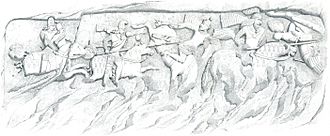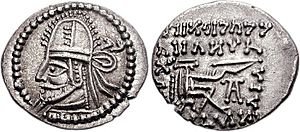Battle of Hormozdgan facts for kids
Quick facts for kids Battle of Hormozdgan |
|||||||
|---|---|---|---|---|---|---|---|
 1840 illustration of a Sasanian relief at Firuzabad, showing Ardashir I's victory over Artabanus IV and his forces |
|||||||
|
|||||||
| Belligerents | |||||||
| Parthian Empire | Sasanian Empire | ||||||
| Commanders and leaders | |||||||
| Artabanus IV † Dad-windad |
Ardashir I Prince Shapur |
||||||
| Strength | |||||||
| An army larger than Ardashir I's army | 10,000 cavalry | ||||||
The Battle of Hormozdgan was a super important battle that took place on April 28, 224. It was the final big fight between two powerful families: the Arsacid family and the Sasanian family. The Sasanians won this battle. Their victory ended nearly 500 years of Parthian rule in Iran. It also officially started the Sasanian era, which was a new period of history for Iran.
Contents
Why the Battle Happened
Around the year 208, a king named Vologases VI became ruler of the Arsacid Empire. He was in charge for a few years. But then, his brother Artabanus IV started a fight for the throne. By 216, Artabanus IV controlled most of the empire. Even the Roman Empire recognized him as the main ruler.
Artabanus IV soon had a conflict with the Roman emperor Caracalla. He managed to stop the Romans at a place called Nisibis in 217. They made peace the next year. The Arsacids kept most of their land in Mesopotamia.
Meanwhile, the Sasanian family was becoming very strong in their home region of Pars. A prince named Ardashir I led them. He started taking over nearby areas and even lands further away. At first, Artabanus IV didn't worry much about Ardashir I. But as Ardashir I grew more powerful, Artabanus IV knew he had to stop him.
Where the Battle Took Place
Historians are not completely sure about the exact spot of the battle. Some old writings suggest it was in a place called bʾdrjʾan. But this doesn't seem likely.
Another old text says the battle happened at Khosh-Hormoz. This is another name for the city of Ram-Hormoz. Ram-Hormoz is near Arrajan and Ahvaz. This makes sense because it means Hormozdgan might have been another name for Ram-Hormoz. The city of Ram-Hormoz is still there today. It's about 65 kilometers east of Ahvaz. It sits in a wide, flat area perfect for a battle with horse soldiers.
How the Armies Prepared

According to one historian, Ardashir I and Artabanus IV agreed to meet in Hormozdgan in April. But Ardashir I arrived early. He chose a good spot on the plain. He dug a ditch to protect his soldiers. He also took control of a spring for water.
Ardashir I's army had about 10,000 horse soldiers. Some of them wore flexible chain armor, similar to what Roman soldiers wore. Artabanus IV had more soldiers. However, their armor was less comfortable. They wore heavy lamellar armor. Ardashir I's son, Shapur, also fought in the battle. You can see him in old Sasanian stone carvings. The battle happened on April 28, 224. Artabanus IV was defeated and killed. This ended the Arsacid rule and started 427 years of Sasanian rule.
What Happened After the Battle
After the battle, Ardashir I had the main secretary of the dead Parthian king, Dad-windad, put to death. Then, Ardashir I took the special title of shahanshah. This means "King of Kings". He began to conquer more land. This new land would be called Iranshahr, or Ērānshahr.
Ardashir I celebrated his big win. He had two stone carvings made in his royal city of Ardashir-Khwarrah. This city is now called Firuzabad. The first carving shows three fighting scenes. One part shows a Persian noble grabbing a Parthian soldier. Another shows Shapur killing Dad-windad with his spear. The last part shows Ardashir I throwing Artabanus IV off his horse.
The second carving probably shows what happened after the battle. It shows the winning Ardashir I receiving a special symbol of kingship. He gets it from the Zoroastrian god Ahura Mazda over a fire altar. Shapur and two other princes are watching.
Soon after 228, Ardashir I's forces pushed Vologases VI out of Mesopotamia. The main Parthian noble families were still powerful in Iran. But now, the Sasanians were their new rulers. The early Sasanian army was very similar to the Parthian one. Most of their horse soldiers were the same Parthian nobles who used to serve the Arsacids. This shows that the Sasanians built their empire with help from other Parthian families. Because of this, their empire has been called "the empire of the Persians and Parthians."
Even though the Arsacid Empire was gone, people still remembered it. Later, in the late 500s, some Parthian leaders tried to bring back the old empire. But their attempts were not successful.
Images for kids
-
The rock relief of Ardashir I's triumph over Artabanus IV
-
Ardashir I receiving the badge of kingship over a fire shrine from the Zoroastrian supreme god Ahura Mazda





